| Author | Message | ||
| davehouck
Moderator Username: davehouck Post Number: 1615 Registered: 5-2002 |
This may have been discussed before; in fact, I may have asked this question before. I broke another string (TI Jazz Rounds) at rehearsal Sunday. It seems to me that this is happening a bit too often (especially given the cost of the TI's). The strings are breaking right at the saddle; D's and G's. Each time after this has happened, before putting on new strings, I've gently sanded the edge of the saddle, hoping to eliminate any rough spots that may be contributing to the breakage. I anchor my thumb on the bridge pickup and thus play right at the bridge when using finger style. And I do play with a wide range of dynamic attack, which means quite often I do use a lot of force. I do not want to change string brands, I love my TI Jazz Rounds; and I do not want to change the way I play. I'm hoping the solution is in the saddles. I'm thinking of ordering new saddles from Alembic that are completely rounded. I'm also wondering if having the saddles plated would help keep them smooth. And I'm even wondering if maybe raising the tailpiece might help by reducing the angle of the string at the saddle. After all, my bridge is higher than where a lot of other folks have theirs set at. Any thoughts?? | ||
| bob
Senior Member Username: bob Post Number: 406 Registered: 11-2002 |
How about some photos? A nice side view so we can see what the break angle looks like (taken from the G side), maybe a super closeup of the string exiting the saddle on the neck side, and perhaps also the bridge side. And of course, a closeup of the saddle itself, right after breaking a string (or at least before more sanding). You don't really want these things to be rounded. Ideally, the saddle should be a half circle that perfectly fits the string, with full contact on the neck side (you can be a little sloppier on the tailpiece side. Any chance that your slots are just too wide, or perhaps a little narrow? | ||
| mica
Moderator Username: mica Post Number: 2388 Registered: 6-2000 |
Usually if a string is repeatedly brreaking right at the saddle, it's either a burr on the saddle or the string manufacturing itself. Back in the early days of Alembic we used Pyramid Gold strings. We supplied an extra G string, because as good as they sounded, they always broke. Do your saddles have V shaped slots or U shaped slots. | ||
| bsee
Senior Member Username: bsee Post Number: 877 Registered: 3-2004 |
Wouldn't the string angle over the bridge saddle matter here as well? If the bridge were high relative to the tailpiece, the angle would be more severe. I would think that would make it easier to break strings. Maybe one of those extremely attractive ebony shims under the tailpiece might help? -Bob | ||
| mica
Moderator Username: mica Post Number: 2390 Registered: 6-2000 |
If the height was really extreme (imagine the bridge a foot above the surface), it could be a contributing factor, but the angle doesn't really change that much across the adjustment range of the bridge. After consulting with my dad, he agrees that this change in angle doesn't seem significant. Unless the rails of the bridge have been modified, if you raise the bridge very high, the strings will lay right on them. You can use anything under the tailpiece as a test shim if you want to keep the bridge height but reduce the angle off the anchor. James recommends that sandpaper may not be getting to the burr (try and see if you can feel it with your fingernail). Try filing with a small round needle file. Echoes to Bob's photo requests. Also, please send us one of the broken strings - we might learn something from it. One last thing: when you say the strings are breaking "too often" what interval are we talking about? | ||
| davehouck
Moderator Username: davehouck Post Number: 1616 Registered: 5-2002 |
A testament to my lack of photography skills.  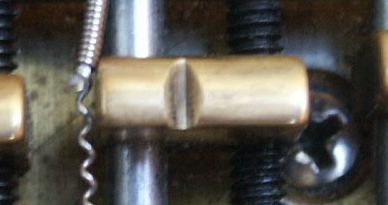  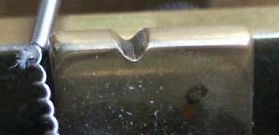 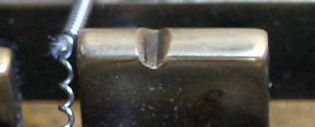  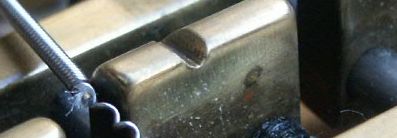 | ||
| davehouck
Moderator Username: davehouck Post Number: 1617 Registered: 5-2002 |
Oh, and one of the angle. 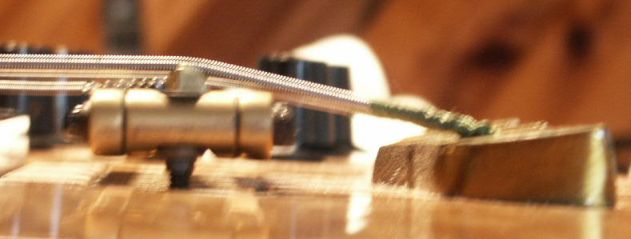 | ||
| wideload
Member Username: wideload Post Number: 84 Registered: 6-2003 |
Dave- If the strings are breaking too often, maybe try putting on a new string instead of the old shortened one??! (How often do they break? Just once!) Larry | ||
| davehouck
Moderator Username: davehouck Post Number: 1618 Registered: 5-2002 |
Bob Novy; I just reread your post and now realize I didn't get the pics you were asking for! Well, after waiting around all afternoon for the camera batteries to recharge, it only took me an hour and a half to get the pics that I did <g>!! Mica; I agree, the angle doesn't seem extreme. I like the needle file suggestion. I'll half to make a trip into town and see what I can find at the hardware store. Is there any particular size I should look for? The slots seem very small for a file! I hope the pics that I did get are useful. It doesn't look like I got close enough to determine whether or not there is a burr. It feels smooth to my finger. And looking at it with a magnifying glass, it looks pretty good. To answer Bob's question about snugness, it looks like a pretty good fit. As to frequency; after reviewing available evidence it may be the case that I was exagerating. I was thinking this was the third break in about 6 months but it was only the second. I was mistakenly including a break on one of my other basses. So it would appear the strings are lasting about 3 months. I would guess I practice an average of 30 minutes a day (not nearly enough <g>) with a rehearsal once every couple of weeks lasting an average of maybe 5 hours. So, am I overreacting?? | ||
| bsee
Senior Member Username: bsee Post Number: 879 Registered: 3-2004 |
Well, from that photo, I would discount my thoughts on the angle. It doesn't look particularly severe at all. | ||
| davehouck
Moderator Username: davehouck Post Number: 1619 Registered: 5-2002 |
Larry; tying them in knots was causing a lot of fret buzz!! | ||
| davehouck
Moderator Username: davehouck Post Number: 1620 Registered: 5-2002 |
I guess one reason it seemed like they were breaking too often is that I've had the same problem with my Essence 4 and my Spoiler. Mica, the Essence is in your shop and you may want to glance at the saddles on it if it's any help. Although it does seem that by sanding the Essence saddles I did eventually get it to the point where it quit breaking. Come to think of it though, I never did use TI's on the Essence before I shipped it to Santa Rosa. With the Spoiler, there's only been one break; and that set lasted maybe six months of normal use. So, maybe I am overreacting!! | ||
| mica
Moderator Username: mica Post Number: 2391 Registered: 6-2000 |
This part looks a little suspect:  Is the little ledge I think I see there in real life? When the string is in place, this might wear over time at this concentrated point, that will cause more weakness and eventually a break. From the top picture, it almost looks like the string is wearing on the leading rail - is that the case? I was looking around Thomastik's website and this was on the front page: When to change strings A string's component materials will eventually become fatigued. This is particularly true for the string core. The richness of higher partials and fullness of tone become degraded. First and foremost this happens with intensive amounts of playing. To avoid sound quality loss we strongly advise changing strings at appropriate intervals. Changing single strings instead of the whole set at once, i.e. mixing old and new strings, will jeopardize the entire tonal balance of the instrument. -- Since it is the core that broke, it may be considered normal. I sent a message to Thomastik-Infeld and will let you know when I receive their response. | ||
| sfnic
New Username: sfnic Post Number: 1 Registered: 3-2005 |
That's what occured to me, too, when I saw the pics. The leading edge of the saddle looks to have a relatively sharp--not an edge, per se, but a change of aspect between horizontal and vertical. It doesn't look like there's a burr there, but rather that the top-to-face corner is fairly sharp. It also looks like the string isn't resting on the bottom of the groove, but rather contacts the groove walls up about 1/4 string diameter on each side. The drop-away angle of the saddle top also looks like it may be steeper than the actual string angle back to the tailpiece. If so, then the string isn't being supported all the way across the saddle, and instead is resting on the front lip, as mica points out. From the wear pattern in the saddle, it looks like the string contacts the saddle for about three wraps, then the saddle top begins to "fall away" from under the string. It also looks like the saddle groove is not quite in alignment to the string; both the first and second pictures show that one wall of the groove is "flat" while the other is "rounded." I think the main "cutting edge" pressure point is about 1/4 string diameter up on the front edge of the notch, just about exactly where mica's arrow is. In her picture, you can see about three string windings "embossed" in the saddle on that side, and a pretty clean "fulcrum point" at the face. If that _is_ the break point, it's a little tricky to fix. If you file that point of the groove to round-over the lip, you move the apex of the saddle backwards somewhat. Then you start to introduce saddle rattle possibilities. A _very_ fine needle file should be able to round that front edge over; the idea is to change the groove contour to allow the string to contact the saddle along the entire bottom 1/2 of its diameter, while moving the apex point from the exact edge back no more than about 1 winding width. Smoothing out the winding embossing will also help a bit. Also, relieving the lateral pressure on the back end of the string, where the saddle groove prevents it from running straight to the tailpiece will also help. Carefully widen the back end of the groove on the "screw" side of the saddle to relieve the cross-grove tension on the string. Looking at the string itself supports (to my mind) the idea that the string isn't resting completely on the bottom of the groove. I think there's a pinching action going on between the contact points on each side of front lip that's putting extra pressure on the core. The winding embossing in the saddle also suggests a lot of pinch pressure which, coupled with the extra pressure introduced by the groove-to-tailpiece misalignment, could be what's stressing the core. Finally, the front edge of the bridge frame looks like it's got some string wear on it, which is odd, as the side view picture indicates there's plenty of clearance. That side view also shows that the down-angle from the bridge to the tailpiece is not too severe; that shouldn't be causing any problems. Shimming the tailpiece would most likely result in a slightly looser feel on the strings, but probably wouldn't affect the breakage problem. nic (Greeting all, btw. I'll swing over to Introductions a bit later and post a howdy over there.) | ||
| davehouck
Moderator Username: davehouck Post Number: 1623 Registered: 5-2002 |
Hi Nic; welcome, and thanks! I looked some more with the magnifying glass and lamp at the edge where Mica's arrow is pointing . When I came back to the computer and read Nic's post, what I had been looking at seemed to correspond with what he was describing. The edge at the face on the left side of the groove, where Mica's arrow is, does not appear to be even. And it does seem that, as Nic has suggested, that the string may be rubbing on a high point such that it is not resting smoothly on the bottom of the groove. Given that, what Mica has suggested seems reasonable, that the wear is being concentrated at that point. However, I must admit that it takes a lot of looking with the magnifying glass for me to see the unevenness. Both Mica and Nic mentioned that the front rail looks like it may have string wear. This does not seem likely; the other three strings do not touch the rail when pushed down in an abnormal fashion. However, I've only owned this bass for about seven months, so this "wear" may predate me. The quote from the TI site that Mica provided (thanks!) talks about tone degradation. And this may be part of my thinking the strings are breaking too soon. Because, to my ears, the strings still sound great!! I've reread Nic's points several times now, and I think I understand everything he is saying. And though I don't think of myself as someone who is skilled in doing fine detail work of this nature; if I can get the right tool, I'll give it a try. I must admit though that it does sound difficult! I'm wondering where I should go to find a "very fine" needle file. My first searches on the web have uncovered some promising leads. | ||
| bob
Senior Member Username: bob Post Number: 408 Registered: 11-2002 |
nic - wow, that saved me a lot of writing, nice to have you here. Stick around, please. My first reaction was that it was a pretty ugly looking slot, neither V nor U, and some nasty looking grooves and edges. No offense, Dave :-) Nothing extreme about the break angle. Even if it is shot from the opposite side, the fat side isn't excessive and the G is less. Agreed. (Almost too bad, those ebony spacers are really quite nice...). I'll also be curious to hear what TI has to say. I understand the concept of the uneven pressure on the windings, translating into stress on the core, but given how soft their nickel is, I probably would have expected the winding to fail. Curious. As for files, it would be great to have a properly sized set of nut files, but they're pretty expensive. I have a "6 piece needle file set" from a company named Gyros, that I bought at my local Orchard Supply. It includes a round needle file that I've used on both my bridge and nut. For a G string, you can only use about the last 1/2 inch of the file, but if you're very patient, careful, and do it under a magnifier it will work. Your slot was apparently done for a larger gauge. That's okay, just focus on the half round that your string will sit in. I suggest filing parallel to the way the string runs up the neck, until you get a really nice clean fit as it exits the saddle. Then file the tailpiece side, following that angle, and finally smooth out the angle in between. Better to go a little wider and deeper on the tailpiece side, if in doubt. You'd like the string to be held firmly, half way around, just as it heads up the neck. I might speculate that slop here could be contributing to the problem, because then the string would end up rattling around in the slot - but it's getting late for such heavy thoughts... -Bob (Dave - the pictures are just fine, really helpful.) | ||
| bigredbass
Advanced Member Username: bigredbass Post Number: 395 Registered: 9-2002 |
While I know our favorite strings are a hard habit to break, I wouldn't do a thing until I tried some RotoSounds, or Boomers, etc., and see if THEY break too. Filing nut or bridge saddles is truly a one way trip (ya can't put the material back!), and it makes me real suspicious that you're breaking Gs AND Ds: That two saddles wold have been cut the same way originally and have now worn the same way over time just seems like pretty long odds to me. Yes, I might radius the edges of the slots, and the bridge to tailpiece angle would have to be at an unplayable height to generate a big leverage towards breaking the strings. But I'd sure try some other strings first. In my wild misspent youth, I used to break Es and As, asI was bashing the holy hell out of them with big Fender 355 triangle heavy picks. I finally decided I'd enriched James Howe, Ltd. enough, played more lightly and I never broke another string. This was before I learned to be my own tech and I never even looked at the bridge, never crossed my mind. J o e y | ||
| basso
Member Username: basso Post Number: 60 Registered: 3-2004 |
I had this problem too with my S1,i bought some very small files,the type that a jeweller would use and gently rounded the leading edge of the saddles,since doing this i've had no more strings breaking,i hope this may be of some help to you,but you may need to remove the bridge as i did to do it correctly,good luck,Julian. | ||
| davehouck
Moderator Username: davehouck Post Number: 1625 Registered: 5-2002 |
Joey; upon further review, it may be that on this bass both breaks were D's, as I was able to determine that on the Spoiler the break was on the G. (I get easily confused <g>). As to your suggestion of trying different strings to see if the problem is in the strings; respectfully, I just have no desire to put something different on my bass for three months just to see if it breaks. I am very happy with my tone right now, and my strings are a big part of that. I also love the feel of the TI's and the tactile response of the strings to my fingers is very important to the way I play. Julian; where did you get the jeweller's files? Bob; at this point I'm wondering just how expensive a "properly sized set of nut files" would be. | ||
| davehouck
Moderator Username: davehouck Post Number: 1626 Registered: 5-2002 |
Stewart-MacDonald has a set of needle files here. | ||
| dadabass2001
Advanced Member Username: dadabass2001 Post Number: 362 Registered: 6-2002 |
Dave, you are a true "Moder" (Hi Paul). Reading this thread, it appears you chimed in at the end with a supplier to your own question regarding needle files. Nice you could help yourself out (LOL). Mike | ||
| davehouck
Moderator Username: davehouck Post Number: 1627 Registered: 5-2002 |
I was just getting ready to post a thank you to myself <g>. | ||
| son_of_magni
Intermediate Member Username: son_of_magni Post Number: 170 Registered: 1-2004 |
I haven't carefully read all the posts in the thread so please excuse me if this is redundant. Since it is the core that is breaking I don't think any kind of defect of the saddle could be causing it. Since it is breaking at the edge of the saddle away from the tailpiece it isn't the string angle. And since it happens on your other basses I would look for something common to all three, and I think you know what that is. If you play very close to the bridge and with a heavy feel, you are stressing the core by bending it back and forth much more than if you played closer to the neck. Like bending a piece of wire backing and forth until it breaks. You may just have to live with it... - Karl | ||
| davehouck
Moderator Username: davehouck Post Number: 1629 Registered: 5-2002 |
Karl; from time to time I think about a thumb rest. They have several advantages. But at the moment I'm not inclined to go that route. And then of course the thing about playing at the bridge is the tone and tactile response it gives you. So you may be right, I may just have to live with it. | ||
| lbpesq
Senior Member Username: lbpesq Post Number: 430 Registered: 7-2004 |
Nic: Welcome to the club. Quite an impressive first posting - sort of like hitting a grand slam home run in your first major league at bat! Please stick around, I'm sure your obvious knowledge will be very much appreciated around here. Are you a luthier? I'm across the Bay from you. If you haven't already, let me suggest taking the short drive north on 101 for an Alembic factory visit. Big fun! Bill, the guitar one | ||
| sfnic
New Username: sfnic Post Number: 4 Registered: 3-2005 |
Hi, Bill, and thanks for the welcome. Grand slam, my butt. Just looking at the pictures and mouthing off. <g> Luthier, yes sort of. I've been associated with guitarmaking for years (detailed bio in the Introductions section), but until about two years ago I had never started to put it all together. I've done setups forever, and extensive electronics fiddling about, but have never built an entire guitar on my own. A friend and I are starting up a small shop, and now that the tooling is in place, we'll be building some one-offs and prototypes, but that's going to be later on this summer. I originally started lurking here to pick up some construction tips from the masters. I definitely so want to do the factory tour; I'm hoping to get up there sometime in the next 2-3 weeks. nic | ||
| slapbass
Junior Username: slapbass Post Number: 18 Registered: 3-2005 |
Dave, If you can't find a good set of needle files let me know and I will ship you a set of nut files. When your done just send them back. I know how hard it is to not have the right tool so this may help you out with the sting breakage issue. Dale | ||
| davehouck
Moderator Username: davehouck Post Number: 1648 Registered: 5-2002 |
Thanks Dale; I might get in to town tomorrow to see what I can find. And I did come up with a couple ideas on the net. But if nothing pans out soon, I'll let you know. | ||
| basso
Member Username: basso Post Number: 61 Registered: 3-2004 |
Dave you can get the files from most jeweller's supplies,i didn't have a problem here in the UK ,it did the trick for me,good luck,Julian. | ||
| dannobasso
Advanced Member Username: dannobasso Post Number: 255 Registered: 3-2004 |
You can get a set of needle files at Sears Hardware folks. Home Depot, Lowes should also carry sets and individual files. Embrace doing things yourself as best you can. Danno | ||
| davehouck
Moderator Username: davehouck Post Number: 1655 Registered: 5-2002 |
I picked up a needle file yesterday at a local hobby shop. But I may check the local hardware stores just to see what they have. |